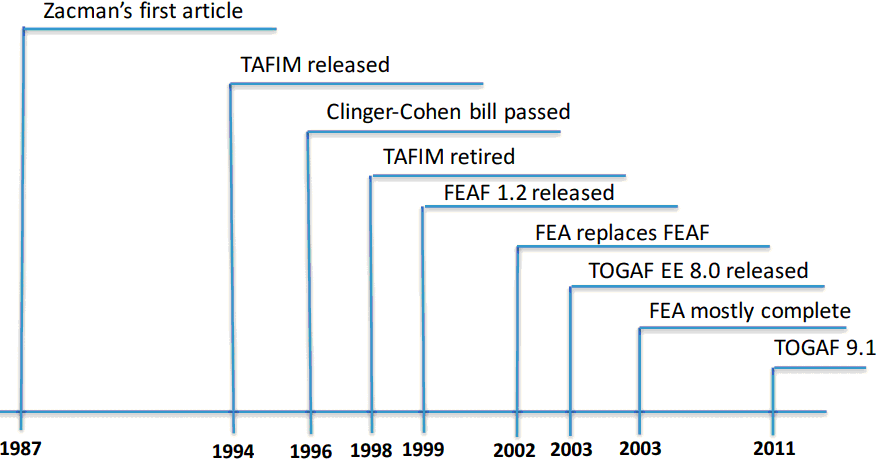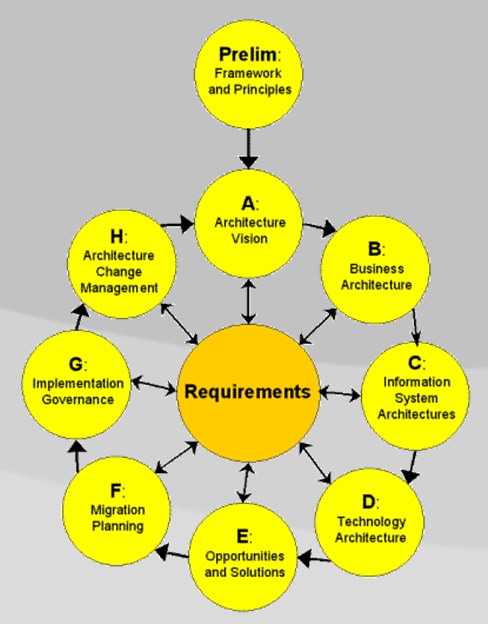A Brief History of Enterprise Architecture
(From Arnab Chattopadhaya ‘s Enterprise Security Architecture)

Enterprise Architectural Methodologies
• Consortia-developed Frameworks
– ISO 19439
– RM-ODP (ITU-T X.901-904)
– TOGAF
• Defense Industry Framework
– DoDAF
– MODAF
– NAF
• Government Framework
– ESAAF
– FEAF
– NIST Enterprise Architecture Model
• Open Source Frameworks
– TRAK
– SABSA
• Proprietary Frameworks
• Zachman Frameworks
• IAF (Capgemini, 1993)
Case Study to Compare Zachman Framework (Taxonomy) with TOFAF
How Zachman Taxonomy can help DreamKart – Summary
• Five ways Zachman Taxonomy can help:
– Ensure that every stakeholder’s perspective has been considered for every descriptive focal point
– Improve the DreamKart Enterprise Architecture artifacts themselves by sharpening each of their focus points to one particular concern for one particular audience
– Ensure that all of CxO’s business requirements can be traced down to some technical implementation
– Convince Business function of the organization that the technical team isn’t planning on building a bunch of useless functionality
– Convince Technology team that the business folks are including IT teams in their planning
What Zachman Taxonomy does not provide
• Does not provide step-by-step process to create new architecture
• Does not provide much help in validating an architecture
• Does not provide help in deciding future architecture
• Inference: Zachman alone would not be sufficient to meet DreamKart’s challenges
TOGAF compliments Zachman
– Zachman tells how to categorize architecture artifacts
– TOGAF gives the process to create them
====================================================================
EA = S (Strategy) + B (Business) + T (Technology)
Technology = Information / Data + Systems / Applications+ Networks / Infrastructure
Core is ADM.
ADM = ARCHITECTURE DEVELOPMENT METHOD


There are four major parts to Enterprise Architecture:
- Business Architecture
- Data or Information Architecture
- Application Architecture
- Technology Architecture
There are six overall elements to TOGAF documentation (see fig):

- Architecture Capability: This element offers guidance to those looking to set up an Enterprise Architecture practice. It offers organizational models and defines roles and responsibilities.
- Architecture Development Method (ADM): The central element to TOGAF. The ADM provides a step-by-step approach to developing an enterprise architecture.
- Guidelines & Techniques: Building on the previous element, this piece helps in adapting and customizing the ADM based on the more specific nature of your business.
- Reference Models: This element offers two architectural reference models, these being the TOGAF Technical Reference Model (TRM), and the Integrated Information Infrastructure Reference Model (III-RM).
- Enterprise Continuum & Tools: This addresses the taxonomies and tools to classify and store the enterprise’s architecture activity output. The Enterprise Continuum offers a view of the Architecture Repository. This view shows the related architectures and their evolution; from generic to specific, from abstract to concrete and from logical to physical.
- Architecture Content Framework: This element outlines the TOGAF content framework.
=====================================================================
References:
- Enterprise Security Architecture—A Top-down Approach : Enterprise frameworks, such as Sherwood Applied Business Security Architecture (SABSA), COBIT and The Open Group Architecture Framework (TOGAF), can help achieve this goal of aligning security needs with business needs.